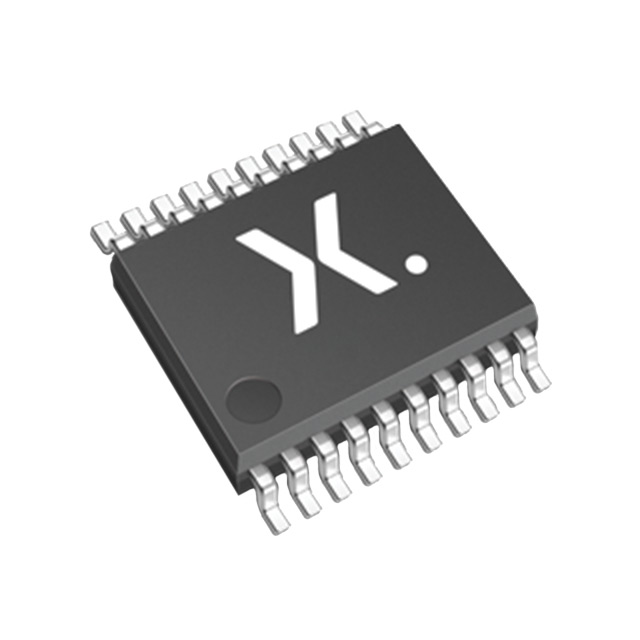Lihat spesifikasi untuk detail produk.

74LVC240APW,112
Product Overview
- Category: Integrated Circuit (IC)
- Use: Logic Gate
- Characteristics: Low Voltage CMOS Octal Inverting Buffer/Line Driver with 5 V Tolerant Inputs/Outputs
- Package: TSSOP (Thin Shrink Small Outline Package)
- Essence: High-performance buffer/driver IC with voltage level translation capability
- Packaging/Quantity: Tape and Reel, 2500 units per reel
Specifications
- Supply Voltage Range: 1.2 V to 3.6 V
- Input Voltage Range: -0.5 V to 7 V
- Output Voltage Range: 0 V to VCC + 0.5 V
- Operating Temperature Range: -40°C to +125°C
- Input Capacitance: 4 pF
- Output Capacitance: 6 pF
- Propagation Delay: 3.8 ns (typical)
- Output Drive Capability: ±24 mA
Detailed Pin Configuration
The 74LVC240APW,112 has a total of 20 pins arranged as follows:
+---+--+---+
A1 -|1 +--+ 20|- VCC
A2 -|2 |- B1
A3 -|3 |- B2
A4 -|4 |- B3
A5 -|5 |- B4
A6 -|6 |- B5
A7 -|7 |- B6
GND-|8 |- B7
OE -|9 |- B8
Y1 -|10 |- A8
Y2 -|11 |- A7
Y3 -|12 |- A6
Y4 -|13 |- A5
Y5 -|14 |- A4
Y6 -|15 |- A3
Y7 -|16 |- A2
Y8 -|17 |- A1
GND -|18 |- OE#
+----------+
Functional Features
- Octal inverting buffer/line driver with 3-state outputs
- 5 V tolerant inputs and outputs for interfacing with different voltage levels
- High-speed operation with low power consumption
- Schmitt-trigger action on all inputs for improved noise immunity
- Balanced propagation delays for simultaneous switching outputs
- ESD protection exceeding 2000 V HBM per JESD22-A114 and 1000 V CDM per JESD22-C101
Advantages and Disadvantages
Advantages: - Wide supply voltage range allows compatibility with various systems - 5 V tolerance simplifies interfacing with legacy devices - High-speed operation enables efficient data transfer - Schmitt-trigger action enhances noise immunity - Balanced propagation delays ensure reliable signal transmission - ESD protection safeguards against electrostatic discharge damage
Disadvantages: - Limited output drive capability may restrict use in certain applications - TSSOP package may require careful handling during assembly
Working Principles
The 74LVC240APW,112 is a logic gate IC that functions as an octal inverting buffer/line driver. It accepts input signals and provides inverted outputs through its 3-state outputs. The device operates within a wide supply voltage range, allowing it to be used in various systems. The 5 V tolerant inputs and outputs enable seamless integration with both 3.3 V and 5 V logic levels. The Schmitt-trigger action on all inputs ensures improved noise immunity by providing hysteresis. The balanced propagation delays of the outputs enable simultaneous switching without causing timing issues. The IC also incorporates ESD protection to prevent damage from electrostatic discharge.
Detailed Application Field Plans
The 74LVC240APW,112 is commonly used in applications that require voltage level translation and signal buffering. Some specific application fields include:
- Microcontroller interfacing: The IC can be used to interface microcontrollers operating at different voltage levels, allowing seamless communication between them.
- Data transmission systems: It can be employed in data transmission systems to buffer and invert signals, ensuring reliable and accurate data transfer.
- Industrial automation: The IC finds use in industrial automation systems where it helps interface various control signals with different voltage requirements.
- Communication equipment: It can be utilized in communication equipment such as routers and switches to handle signal conversion and buffering tasks.
- Automotive electronics: The IC is suitable for automotive applications where it assists in voltage level translation and signal conditioning.
Detailed and Complete Alternative Models
Some alternative models that offer similar functionality to the 74LVC240APW,112 are:
- SN74LVC240APWR - Texas Instruments
- MC
Sebutkan 10 pertanyaan dan jawaban umum terkait penerapan 74LVC240APW,112 dalam solusi teknis
Sure! Here are 10 common questions and answers related to the application of 74LVC240APW,112 in technical solutions:
Q: What is the function of the 74LVC240APW,112? A: The 74LVC240APW,112 is an octal buffer/line driver with 3-state outputs. It is used for signal buffering and driving in digital circuits.
Q: What is the maximum operating voltage for the 74LVC240APW,112? A: The maximum operating voltage for the 74LVC240APW,112 is typically 3.6V.
Q: Can the 74LVC240APW,112 be used with both CMOS and TTL logic levels? A: Yes, the 74LVC240APW,112 is compatible with both CMOS and TTL logic levels.
Q: How many inputs and outputs does the 74LVC240APW,112 have? A: The 74LVC240APW,112 has 8 inputs and 8 outputs.
Q: What is the maximum output current that the 74LVC240APW,112 can drive? A: The 74LVC240APW,112 can typically drive up to 24mA of output current.
Q: Is the 74LVC240APW,112 suitable for bidirectional communication? A: Yes, the 74LVC240APW,112 supports bidirectional communication by using its 3-state outputs.
Q: Can the 74LVC240APW,112 be used in high-speed applications? A: Yes, the 74LVC240APW,112 is designed for high-speed operation and can be used in applications with fast switching requirements.
Q: Does the 74LVC240APW,112 have built-in protection against overvoltage or ESD events? A: The 74LVC240APW,112 does not have built-in protection against overvoltage or ESD events. External protection measures may be required.
Q: What is the power supply voltage range for the 74LVC240APW,112? A: The power supply voltage range for the 74LVC240APW,112 is typically from 1.65V to 3.6V.
Q: Can the 74LVC240APW,112 be cascaded to increase the number of inputs/outputs? A: Yes, multiple 74LVC240APW,112 ICs can be cascaded together to increase the number of inputs and outputs in a circuit.
Please note that the answers provided here are general and may vary depending on specific datasheet specifications and application requirements.

